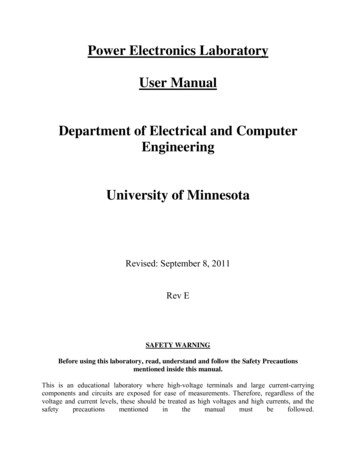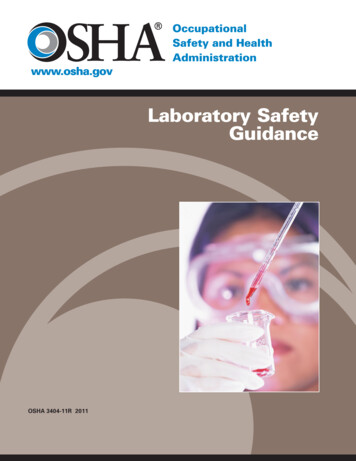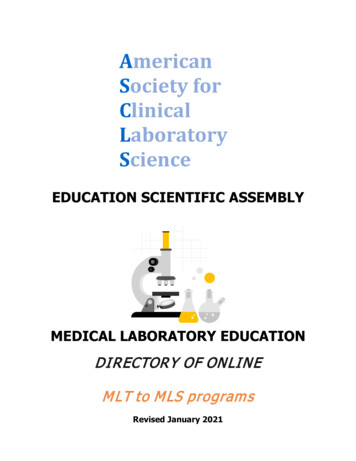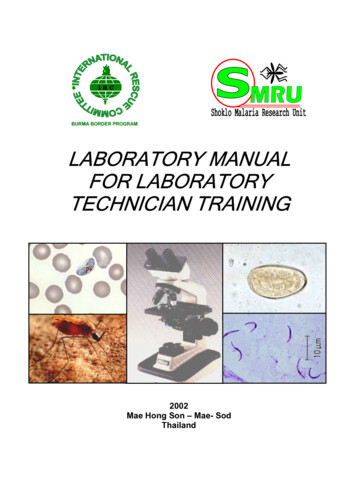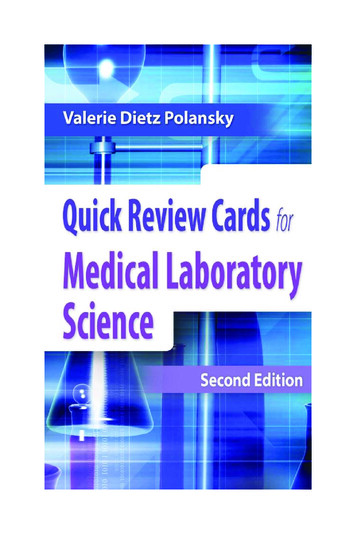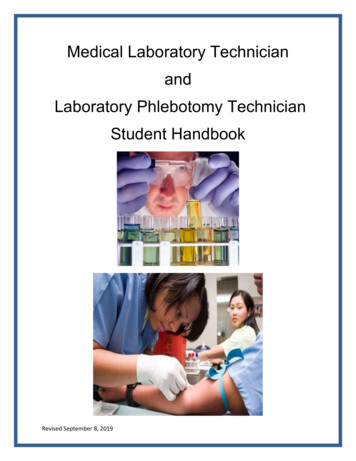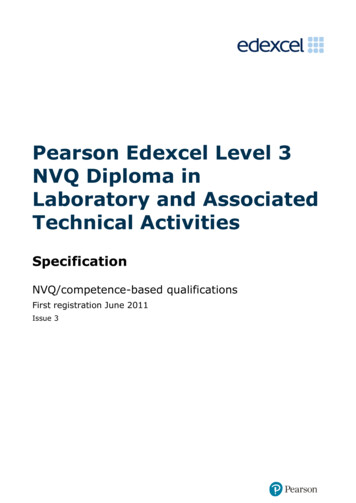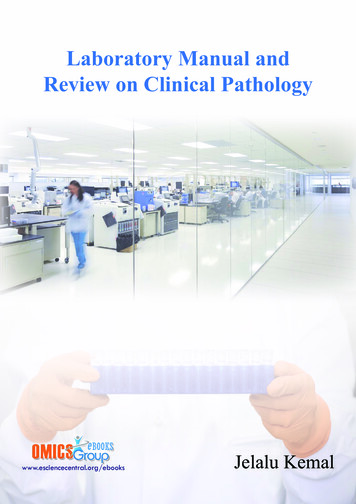
Transcription
www.esciencecentral.org/ebooksOMICS Group eBooksLaboratory Manual andReview on Clinical PathologyJelalu Kemal001
Laboratory Manual and Review on ClinicalPathologyAuthor: Dr. Jelalu KemalPublished by OMICS Group eBooks731 Gull Ave, Foster City. CA 94404, USACopyright 2014 OMICS GroupThis eBook is an Open Access distributed under the Creative Commons Attribution 3.0license, which allows users to download, copy and build upon published articles even forcommercial purposes, as long as the author and publisher are properly credited, whichensures maximum dissemination and a wider impact of our publications. However, userswho aim to disseminate and distribute copies of this book as a whole must not seek monetarycompensation for such service (excluded OMICS Group representatives and agreedcollaborations). After this work has been published by OMICS Group, authors have theright to republish it, in whole or part, in any publication of which they are the author, and tomake other personal use of the work. Any republication, referencing or personal use of thework must explicitly identify the original source.Notice:Statements and opinions expressed in the book are these of the individual contributors andnot necessarily those of the editors or publisher. No responsibility is accepted for the accuracyof information contained in the published chapters. The publisher assumes no responsibilityfor any damage or injury to persons or property arising out of the use of any materials,instructions, methods or ideas contained in the book.Cover OMICS Group Design teamFirst published February, 2014A free online edition of this book is available at www.esciencecentral.org/ebooksAdditional hard copies can be obtained from orders @ www.esciencecentral.org/ebooks
ContentsIntroductionObjectives of Clinical Pathology Practical CoursePart One: HematologyBlood CollectionStaining DyesMethods of Staining (staining procedure)Smear PreparationHemoglobin DeterminationHematocrit Determination (PCV)Total Count of RBCTotal Count of WBC (White Blood Cells)Differential Leukocyte CountDetermination of Erythrocyte Sedimentation Rate (ESR)Coagulation Time Determination (Whole Blood Clotting Time)Bleeding TimeCalculating Red Blood Cell IndicesPart Two: Function TestsDetermination of Aspartate Amino Transferase (AST) and) Glutamic Oxalacetate Transminase (GOT)Determination of Alkaline Phosphatase (ALP)Determination of CreatinineTotal Protein DeterminationUrea DeterminationTotal and Direct Bilirubin DeterminationEnzymatic Kinetic Colorimeter Test (GOD – PAP)Liver Function TestWallace-Diamond TestKidney Function TestMicroscopic Examination of Urine SampleProtein TestGlucose TestAcetone (Ketone body)Rumen Function TestSedimentation Activity TimeBacteria ExaminationMicroscopic Examination of Rumen Content Protozoan'sCellulose Digestion TestPancreatic Function TestTrypsinGelatin Test MethodReferencesPage 72728282929293030303031
Laboratory Manual and Reviewon Clinical PathologyJelalu Kemal*Department of Veterinary Pathology and Parasitology, College ofVeterinary Medicine, Haramaya University, Ethiopia*Corresponding author: Jelalu Kemal, Department of VeterinaryPathology and Parasitology, College of Veterinary Medicine, HaramayaUniversity, Ethiopia, Tel: 251 911 953952; E-mail: jelaluk@gmail.comAbstractClinical pathology is a subspecialty of pathology that deals with the use of laboratory methods (clinical chemistry, microbiology,hematology and emerging subspecialties such as molecular diagnostics) for the diagnosis and treatment of disease. Hematologystudies the blood and blood-forming tissues to evaluate presence of disease and assist in therapeutic interventions as clinicallyindicated. Clinical chemistry (also known as chemical pathology and clinical biochemistry) is the area of clinical pathology thatis generally concerned with analysis of bodily fluids. Some of the objectives of this manual are to identify the most importanthematological and functional pathological tests of vet importance, to diagnose different animal diseases by confirming thepathological causes that constraint live stock production and to have knowledge more about clinical pathology. Part one discussesabout hematology which includes equipments and reagents, blood collection sites and procedures, preparation method for workingsolution, staining methods (staining procedures), hemoglobin determination, hematocrit determination (PCV), total RBC count,total WBC count, differential leukocyte count, determination of ESR, coagulation time determination, bleeding time, calculating redblood cell indices and blood group and Rh factor determination. Part two deals with function tests which includes determinationof Aspartate Amino Trasferase (AST) and Glutamic Oxalacetate Transminase (GOT), determination of Alkaline Phosphtase (ALP),determination of creatinine, total protein determination, urea determination, total and direct bilirubin determination, enzymatickinetic colorimeter test, liver function test, kidney function test, rumen function test and pancreatic function test. In general, theoutline of this laboratory manual deals with the basic hematological procedures and clinical chemistry analysis using which is meantfor students use. All of the procedures described in this manual are classical methods that are routinely executed in a standardclinical pathology laboratory.Keywords: Clinical chemistry; Clinical pathology; Hematology; Laboratory tests; ManualIntroductionClinical pathology is one of the two major divisions of pathology, the other being anatomical pathology. Clinical pathology is itselfdivided in to subspecialties, the main ones being clinical hematology/blood banking, clinical chemistry, hematopathology and clinicalmicrobiology and emerging subspecialties such as molecular diagnostics. Hematology studies the blood and blood-forming tissues toevaluate presence of disease and assist in therapeutic interventions as clinically indicated. Clinical chemistry (also known as chemicalpathology and clinical biochemistry) is the area of clinical pathology that is generally concerned with analysis of bodily fluids.Blood parameters play a critical role in diagnosis, assessing progression, and in the characterization of disease and phenotypesin clinical and research situations. The accuracy and reliability of the whole blood parameter analysis depends on identification andcontrol or elimination of variables that may affect these results. Different blood collection and handling strategies represent sourceof variability that can be controlled in many instances.Basic hematological procedures such as the complete blood count are frequently conducted to help physicians and veterinariansarrive at a diagnosis and prognosis, also to evaluate treatment. Hematology testing includes, but is not limited to: HematologySample Processing, Hematology Research Services, Hematology Automated Testing, Lamellar Body Counts, Microscopic CellularAnalysis, Body Fluid Analysis and Specialized Stains.Objectives of Clinical Pathology Practical CourseAt the end of Clinical Pathology practical course the students will be able to:a) Identify the most important hematological and functional pathological tests of vet importanceb) Diagnose different animal diseases by confirming the pathological causes that constraint live stock production in generalc) Have knowledge more about clinical pathologyd) Write lab report pertaining the tests carried outOMICS Group eBooksThe outline of this laboratory manual deals with the basic hematological procedures and clinical chemistry analysis which ismeant for students use. The study of hematology begins with proper sample collection and handling. Part one deals with hematologycontaining different sections. Part two covers clinical chemistry including functional tests. All of the procedures described in thismanual are classical methods that are routinely performed in a standard clinical pathology laboratory. Detail procedures includingpreparation of reagents, solutions, stains and buffers are given. Calculations of blood indices and chemical analysis are also discussedin part one and part two respectively.004
Part One: HematologyEquipments and reagents required for hematological blood examination. Hematocrit centrifuge Compound microscope Sahlis instrument Capillary tube Hematocrit reader Distilled water Haemocytometer pipette Haemocytometer counting chamber WBC diluting fluid RBC diluting fluid Slides, cover slip, special cover slip ESR stand, ESR tube Filter paper, blood lancets, lead pencils, marker Giemsa stain, Wright’s stain Vacutainer tubes(different type), vacutainer needles, syringes, needle holder Gloves Blood samples Staining racks and othersBlood CollectionSite: The following lists of veins are the most appropriate blood collection sites from different species of veterinary importanceJagular vein- the most commonly used site in the horse, cattle, sheep, goat, camel and large wild mammals: used occasionally in smallanimals. Vacutainer tube, vacutainer needle, syringe, needle, needle holder, and disinfectant should be used for blood sample.Procedure Placement of the thumb of the left hand in the jagular furrow to occlude and anchor the jagular vein, while manipulating the syringeand needle with the right hand Clipping the site of sampling especially in long haired animals is recommended The veins are more clearly out lined when the site is rubbed with alcoholCephalic vein - The most commonly used site for collection of small amount of blood in the dog. By constricting the area on thedorsal aspects of the fore limb at the level of the elbow which can be raised beginning just above the carpal vein.Ear vein- can be used in small dog, pig, cat and small lab animals (small dog, rabbit, guinea pig, and monkey). A marginal vein on the dorsal side of the ear is selected Remove the hair by shaving, clipping, or other method Swab the skin with alcohol or other Place the left index finger under the ear at the point of applying stylet or syringe Gentle aspiration is used when using a syringe in small animals like rabbit, to avoid collapse of the veinToe or Toe nail – can be used in small dog, puppy, guinea pig etc Clip the hair away Disinfect the capillary bed of the nail Cut in to just short of the base of the nailTail – can be used in pig, cattle, sheep, rat, and mouse Veinipuncture –of the coccygeal vein on the ventral side Amputation – commonest method used in the rat and mouse. A small transverse incision with a razor blade produce drops of bloodHeart – may be used in animals like bird, fish, and othersFemoral or Tibial vessels – used in dog, cat, small mammals, rat etcOMICS Group eBooks Take 20-40 drops as well as 80 drops (4ml) of blood005
Mammary vein – used for dairy cattleThe vein appears at the anterior border of the mammary gland lateral from the linea Alba and runs forward passing through aforamen in the abdominal wall posterior to ribs.Anterior vena cava – used for the pigA needle (4½ – 6 in. and 17 to 20 gauge needle) is inserted just anterior and slightly lateral to the cariniform cartilage and a line fromthe cartilage to the base of the ear.Retro orbital Venus plexus – used for the rat, mouse, guinea pig A best method for obtaining a large quantity of blood (1ml) in mouse This technique is reported to be less traumatic than othersWing vein or comb – used for birds After the feathers in the axillary region are plucked, the alar vein is seen running from beneath the pectoral muscle then along theventral surface of the humerusFigure 1: EDTA tubes should be filled to their labelled capacity. Short filled tube has an excessive amount of EDTA relative to theblood volume. Short filled tubes cause a false increase in total plasma protein content and a false decrease in PCV and RBC count.Figure 2: Collection materials for hematological assessment includesyringe, needles, and purple topped collection tubes that contain EDTA.In most animals up to 0.5 ml/kg blood collection has no any adverse effect. The total volume of blood collection differs in different animals.a. Red-stopper tubes – are for tests requiring clotted bloodb. Lavender stopper tubes – contain EDTA in concentrated liquid or desiccated powder formc. Green stopper tubes – contain heparin and are used for blood gases, PH, (CO2, O2) .d. Gray stopper tubes – contain oxalates, fluorides, or citratese. Yellow stopper tubes – available with Acid Citrate Dextrose (ACD) solution or physiological saline solutionOMICS Group eBooksVacutainer tubes006
AnticoagulantsThe most important anticoagulants that can be used during blood collection with different mode of action are listed below.Anticoagulant / productMode of actionAmount requiredAdvantageDisadvantageEDTA/Ethylene diamine tetraacetic acidForm insoluble Ca salts10-20mg (1ml of 1 % solution Recommended for routinedried at room temp. or athematological procedures,incubatorpreserve cellular elementsbetterHeparinAntithrombin andantithromboplastin1-2mg (0.2ml of 1% solution)Less effect on RBC hemolysis May cause clumping of WBC,unsuitable for smears, as itUsed for blood gas analysisinterferes with stain ability ofWBC expensiveNa citrateCombine with Ca to form aninsoluble Ca salt10-20mg (1ml)Can be used for bloodtransfusionPotassium oxalateUnits with Ca to form insoluble 20mg (2 drops of 20% solution Very solublecalcium oxalatedried in incubatorCauses shrinkage, it increasethe volume of bloodSodium oxalateUnits with Ca to form insoluble 20mgcalcium oxalateSame as potassium oxalateUsed mainly for prothrombintimeMay shrinks cell because Nasalt is less solubleInterferes with many chemicaltests, shrink cellsTable 1: Commonly used anticoagulants, their mode of action and dose required.Staining DyesWright’s stain: Forms of dye available Dry powder as bulk and as preweighted vials, Capsule Readymade solution. Most convenient, but often deteriorated from long storagePreparation of stainConventional method Place 0.5gm of dry Wright’s stain powder in a mortar Add 300ml of absolute methyl alcohol Grind the mixture and pour in dark bottle Shake the bottle each day for about two weeks, then filter Aging of the stain will take 2 to 4 before it will be satisfactory for useAccelerated method Place 0.3gm of dry Wright’s stain powder in a mortar and over lay with 3ml of glycerol, grind thoroughly Rinse with 100ml of absolute methyl alcohol and place in dark container Mix with magnetic stirrer for about 1 wk without heat Filter before useGiemsa StainGeneral consideration Giemsa stain has various azure compounds with eosin and methylene blue It is an excellent stain for blood parasites and for inclusion bodies It stains red granules well but neutrophilic granules and erythrocytes are poorly stained Commercial stock solution are recommended for purchase and are stable indefinitelyPreparation method for working solution: Take one part of giemsa stock solution and nine part distilled water and mix before oneto two hours before use.Leishmen’s stainPreparation Grind 0.15gm of Leishmen’s stain powder with small amounts of absolute methyl alcohol until an even suspension is obtained. Atotal of 100ml methanol is added to produce complete solutionWright’s-Giemsa stain (modified Wright’s stain)Preparation of stain 500mg of dry Wright’s stain powder and 50mg of Giemsa stain powder are ground in a mortar with 100ml of absolute methylalcohol (acetone free) Allow to stand for 24-48 hrs before using Keep well stoppered to prevent evaporation of alcohol or absorption of water vaporOMICS Group eBooks Pour in to a dark bottle and age for a few weeks prior to use007
Commercial Wright’s – Giemsa stain are available Wright – Leishmen stain May – Grunwald –Giemsa stain Methylene blue stain Field’s stain Prussian blue stain and othersBuffered distilled waterPreparation: 5.47g monobasic potassium phosphate and 3.8g of dibasic sodium phosphate with 1000ml of distilled waterMethods of Staining (staining procedure)Wright’s stain Cover the dried blood smear completely with Wright’s stain and allow to stand for 1 to 3 minute Add an equal amount of buffered distilled water or neutral water (pH 6.6 to 6.8 for most animals blood) Blow it gently and allow the mixture to stand for 3 to 5 minutes. A metallic scum should appears green Float off the metallic scum with a stream of water from a wash bottle or from the top. Use distilled water if tap water is too alkaline.Don’t pour the stain off the slide before washing, as this will result in a precipitate forming on the slide Wipe the stain from the back of the slide with cleaning tissue Stand the slide on end, wave gently in the air, or blot gently with bibulous paper to dry Examine the preparation by placing a drop of oil on a slide If a permanent preparation is desired, the oil can be dissolved with xylene and a mounting medium like Canada balsam is applied.Advantage: It conserves stain, Methyl alcohol, and timeDisadvantage: More precipitate is likely to be presentCellCytoplasmChromatinErythrocytesYellow to pinkishPurpleLymphocytesBluePurplish redMonocytesLight bluePurpleEosinophilsYellow to brownish red rodsLight purpleBasophilsDark purple granulesHetrophils/NeutrophilsYellow to brownish red rodsLight purpleThrombocytesGrey-bluePurpleTable 2: Staining characteristics.Giemsa stain method Place dried blood smear in a coplin jar containing absolute methyl alcohol for about 3 minute to fix the smear Drain off the alcohol and allow the slide to dry Transfer the slide to a second coplin jar containing fresh stain and allow staining for 16 to 60 minute. 60 minute staining period isused when blood parasite is suspected. 12 to 18 hrs for inclusion bodies Wash the stain with running/tap water, dry and examine under oil immersion microscopeLeishman’s stain method Flood the air dried blood film with Leishman’s stain and leave for 1 to 2 minute to fix Dilute the stain on the smear with double the volume of buffered distilled water and stain for 5 to 15 minute Blow on the mixture gently Wash with distilled water until the film has a pinkish tingeSmear Preparation Wet smear Thin smear Thick smearProcedures for each preparationWet blood smear/film preparationOMICS Group eBooks Wipe the back of the stain/the slide and allow to dry in upright position008
A drop of blood is placed at the centre of a clean slide Cover with a clean, dry cover slip Examine the film under the microscope (40 objective)The method does not require staining. It is rapid and simple to perform.Extracellular blood parasites such as Trypanosomes and Microfilaria of filarial nematodes can be diagnosed. Note that you can seeonly the movement of TrypanosomesThin blood smears preparationIt can be made by spreading a drop of blood evenly across a clean grease free slide using a smooth edged spreader. Make a drop of blood on one end of glass slide Place the end of second glass slide /spreader slide / against the surface of the first slide, holding at an angle of 30-45 degrees Draw the spreader slide gently into the drop of blood and when the blood has along 2/3 of width of the spreader slide by capillaryaction, push the spreader slide forward with a steady even motion Dry by waving rapidly in the airThick bloods smear preparation A large drop of blood is put at the centre of a clean dry slide The drop is spread with an applicator stick, needle or corner of another slide to cover an area of ½ an inch square The smear is thoroughly dried in a horizontal position so that the blood could not ooze to one edge to the film and protected fromdust, insects and direct sunlight.Causes of inadequately stained blood smearsAnalysis of the poor results will determine what modification of technique is required to correct the problemEntire smear is too blue - granules of neutrophil over stained and larger than normal, and granules of the eosinophil is deep gray. Buffered water, wash water or stain too alkaline Excessive thickness of the smear Alkaline residue to the slide Insufficient washing Prolonged staining before diluting with buffered waterNuclei of leukocytes are pale blue, and the erythrocytes and granules of eosinophils are usually red. Buffered water, wash water or stain too acid Acid residue on slideEntire smear has a pale stain Under staining Weak stain Excessive washing or allowing water to stand on slide Using warm or hot water for washing slideVariation in staining on different areas of the smear Buffered water un evenly applied and not thoroughly mixed with Wright’s stain Acid or alkaline residue on the slide Water not properly drained from slide after washingPrecipitated stain Lack of through washing Precipitate in Wright’s stain not properly filteredHemoglobin DeterminationObjective: To determine the amount of hemoglobin present in 100 ml of blood of a given sample.Significancea. It serves as an index of blood condition of the animal.b. If the hemoglobin [Hb] content falls below the normal levels, it indicates anemia, or pregnancy (physiological).OMICS Group eBooks Evaporation of alcoholic stain009
c. If it increases to the normal value, it indicates polycythemia, decrease in O2 supply, heart disease, emphysema etc.Method: Acid hematin methodRequirements: Sahlis instrument, blood sampleProcedure Take 0.1N HCl (1%) into central graduated tube up to mark 2. Suck the blood exactly up to mark 20 (20 µl) with the help of sahlis pipette. Transfer the blood from pipette to central graduated tube of the hemometer. Mix it well with the help of stirrer or rod and allow it to react for two minute. Make up with distilled water by adding drop by drop until the color matches with the Standard comparator tube and mix well. When the color matches take out and record the values on the side as gm/100ml and or in percentage. Repeat 5 to 6 times and take the average valueNormal value: Bovine 8 - 15gm/dl (11)Equine 11 -19gm/dl (14)Ovine 9 – 15gm/dl (11.5)Feline 8 – 15gm/dl (12)Caprine: 8-14gm/dl (11)Canine 12 – 18gm/dl (15)Hematocrit Determination (PCV)Aim: To determine the hematocrit value for a given blood sample.Principle: Blood compartment is separated into three parts using capillary tube in a hematocrit centrifuge.Method: Wintrobe hematocrite methodSignificance Packed Cell Volume (PCV) erythrocyte mass; anemia when PCV falls dawn. Buffy coat; white to gray layer above PCV. It will give number of WBC (0.5mm to1.5mm).Leukopenia or leukocytosis. Plasma content: usually about 55%, Yellowish in color. Degree of yellowness indicates icterus (jaundice).Requirements: Hematocrit tube, hematocrite centrifuge, hematocrit reader and sealer.Procedure The blood is filled in to a micro hematocrit tube (3/4th) and seals it with sealer. Centrifuge the filled hematocrit tube in a hematocrite centrifuge at 2000 rpm for 4-5 minutes. Read the value (the tube) with hematocrit reader and record the result.Normal value Bovine 37 - 55 % (45%) Ovine 24 - 50 % (38%) Caprine 24 - 50 % (40%) Equine 32 - 55 % (42%) Swine 32 - 50 % (42%)Total Count of RBCObjective: To enumerate the total count of RBC/cumm of a given blood sample.Method: Hemocytometry methodSignificance It performs some functions such as transportation of O2 and CO2 An increase in RBC is referred as PolycythemiaRequirements: Hemocytometer, cover slip, microscope, RBC diluting fluid, Haeyem’s solution or Physiological saline 0.85% Nacl.Procedure Take the blood in to RBC pipette up to 0.5 marks Immediately draw the RBC diluting fluid up to mark 101.OMICS Group eBooks A decrease in RBC accounts for less hemoglobin i.e., anemia0010
Rotate the pipette between thumb and other fingers with finger eight (8) movements. This gives a dilution of 1:200. Clean the counting chamber of hemocytometer and cover slip Place the cover slip in position over the counting chamber by gentle pressure Expel a drop of blood on to the counting chamber by holding the pipette at an angle of 45º. Allow the hemocytometer for 2-3 min to settle down the RBC in counting chamber Counting: Counting rules- Count less than 40 microscope objective- Count cells touching the left and top side lines.- Don’t count cells touching the bottom right side lines.- Count first left to right direction, then to vise verse.Figure 4: The hemocytometer and the direction in which the count should be made.CalculationVolume of one small square 1/20mm 1/20mm 1/10mm 1/4000mm3Volume of 80 small square 80 1/4000mm3 1/50mm3OMICS Group eBooksFigure 3: Hemocytometer grid lines. Erythrocyte and leukocyte count. Red zones to be countedunder high power for erythrocytes. White zones to be counted under low power for leukocytes.0011
Total number of RBC Cells counted (N)/Volume of all squares dilution factorTotal RBC N (cell counted)/1/50mm3 1/200 N 10,000Total Count of WBC (White Blood Cells)Objective: To enumerate the total number of WBC/cumm of blood.Method: Hemocytometer methodSignificanceThe normal WBC performs some important physiological functions. The chief function of it is imparting immunity to the body.Therefore, the decrease or increase in circulating WBC indicates physiological condition i.e., increase in WBC indicates inflammationwhere as decrease in WBC may indicate AIDS.Requirements: Hemocytometer, cover slip, microscope, WBC diluting fluid, or 1% HCl (1% Glacic Asetic Acid) i.e., 1ml GAA 1ml MB 100ml dist.H2O.Procedure Draw the blood in to WBC pipette up to 0.5 marks. Immediately draw the WBC diluting fluid up to 11 marks. Rotate the pipette between thumbs and finger horizontally. This will gives you a dilution of 1:20. Clean the counting chamber of hematometer and cover slip. Place the cover slip on the counting chamber with gentle pressure. Expel the fluid in the pipette by an angle of 45º. Allow the hemocytometer for 2 minute to settle down the WBC. Count the WBC in the 4 large squares in the corners of counting chamber (16 small squares).CountingCount cells touching the left and top side linesDon’t count cells touching the right and bottom side lines# avoid duplication of cellsCalculationTotal WBC count Cells counted 50Area of one smallest square 1/4 1/4 1/16mm2Depth of the counting chamber 1/10mmVolume of one smallest square 1/10mm 1/16mm2 1/160mm34 corners 16 ss 64 ss 1/160mm3 64/160mm3 0.4mm3Total volume 64 ss 1/160mm3 64/160mm3 0.4mm3Dilution 1:20Therefore, Total WBC cell counted/dilution volume cell counted/1:20 0.4 cell counted 20/0.4 cell counted 50Differential Leukocyte CountAim: To enumerate the different types of leucocytes namely neutrophil, eosinophil, basophil, monocyte, and lymphocyte.Significance They are responsible for the defense of the organism They are 5000-7000mm3 Leucocytes divide in to granulocyte and agranulocyteNeutrophils Very active in phagocyting bacteriaOMICS Group eBooksMethod: Blood film (smear) with Wright’s or Giemsa stain0012
Found in highly in pus Died after phagocyting pathogens High during inflammationEosinophilsAttack parasites and phagocyte antigen-antibody complexesBasophils Secrete anticoagulant and vasodilatory substances (histamines, serotonin) Their chief function is secreting substancesLymphocytesThe main constituents of immune system defense against viruses, bacteria, fungi and protista.MonocytesPrecursors of macrophages. Have intense secretory activities (lysosomes, interferons)RequirementsClean glass slide, sterile needle, microscope, stains solution, oil immersionProtocolMaking the smear Place a small drop of blood near an end of the slide Bring another slide in contact with the drop and allow distributing at an angle of 30-40 degrees Push to the left in a smooth and quick motion Dry the slide with airFixing - Dip the smear in a vessel containing 95% containing ethyl or methyl alcohol for 3-5 minutesStaining Stain the smear with Giemsa or Wright’s stain for 16-60 or 1-3 minutes respectively Rinse the slide with distilled water at room temperature Drain off the water and leave the slide to dryCover slippingPlace a drop of Canada balsam on the smear and then mount the cover slipObservation examine under dry objective or oil immersion count about 100-200 cells and take averageInterpretationNeutrophils Very tiny light staining granules Multi-lobed nucleus connected by thin strands of nuclear material Are most numerous, normally they account 50-70% If the count exceeds this amount, the cause is usually due to an acute infection (appendicitis, small pox, rheumatic fever)OMICS Group eBooks If the count is considerably less, it may be due to a viral infection (influenza, hepatitis, rubella)0013
Figure 5: Normal canine neutrophils. Both neutrophils have a lobulated nucleus in a light pink finely granulated cytoplasm.Eosinophils Has large granules (acidophilic), pink red The nucleus often has two lobes connected by a band of nuclear material, looks like telephone receiver which contains digestiveenzymes against parasites.Figure 6: Feline eosinophils. Eosinophil (top) has granules that are pale pink and rod-shaped.Lymphocytes An agranulocyte cell with very clear cytoplasm Very large nucleus which fills almost the cell with leaving thin rim of cytoplasm (Figure 5). Play an important role in our immune response The T-lymphocytes act against virus infected cells and tumor cells The B-lymphocytes produce antibodies 2nd numerous leukocyte, accounting for 25-35% of the counted in differential WBC count When number of this cells exceeds the normal value, one would suspect parasites Patients with AIDS keep a careful watch on their T-cell levelOMICS Group eBooks Smaller than the three granulocytes (N,E,B)0014
F
Laboratory Manual and Review on Clinical Pathology Abstract Clinical pathology is a subspecialty of pathology that deals with the use of laboratory methods (clinical chemistry, microbiology, hematology and emerging subspecialties such as molecular diagnostic


